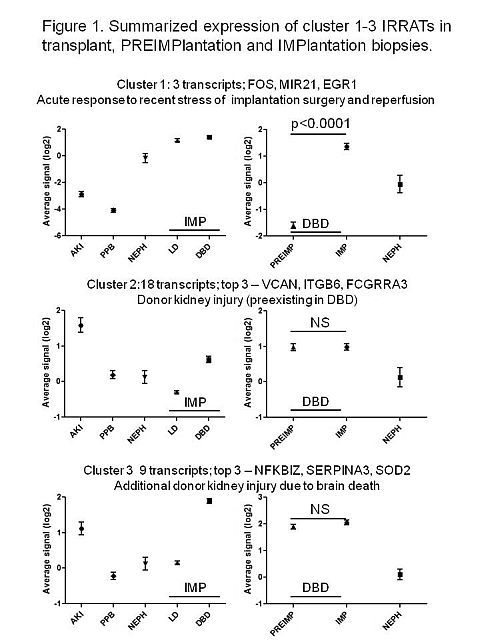Heterogeneity in Transcripts Induced in Implantation Biopsies: Distinguishing Preexisting Injury from Acute Phase Response
Alberta Transplant Appled Genomics Centre, University of Alberta, Edmonton, AB, Canada
Manchester Royal Infirmary, Manchester, United Kingdom
Meeting: 2013 American Transplant Congress
Abstract number: 262
Human kidney transplants with early acute kidney injury (AKI) express transcripts indicating the injury-repair process (IRRATs). Expression of IRRATs correlated with delayed graft function (DGF) within 6 weeks post-transplant. The present study investigated the expression of IRRATs in donor kidneys at transplantation. Our hypothesis was that the preexisting donor molecular signal of AKI is present prior to and after implantation and predicts future graft function.
Expression of the IRRATs was measured by microarrays in biopsies from grafts with early AKI, early stable grafts (PPB), control nephrectomise for cancer (NEPH), and in kidney implantation biopsies from living donors (LD) and donation after brain death (DBD).
K-means clustering identified three IRRAT expression patterns across these conditions. Cluster 1 had the highest expression only after implantation, was also increased during nephrectomy for tumors (NEPH) and represents an acute phase response to surgery rather than older injury. Cluster 1 and did not predict subsequent DGF. Clusters 2 and 3 represented donor kidney injury response developed in DBD donors prior to implantation, and were not further increased after implantation.

Clusters 2 and 3, however, predicted DGF of DBD kidneys. Other transcripts with highly similar expression profiles to clusters 2-3, cluster 2 and cluster 3-like also had good predictive values.
| Prediction of DGF in DBD by summarized expression of cluster 1-3 genes. (Genes with area under ROC > 0.7/total) | ||
| Cluster 1 (0/3) | Cluster 2 (8/18) | Cluster 3 (2/9) |
| 0.58 (ns) | 0.84 | 0.81 |
| Cluster 1-like (1/201) | Cluster 2-like (49/281) | Cluster 3-like (35/324) |
| 0.71 (ns) | 0.84 | 0.87 |
Thus the biopsy at the time of transplantation has heterogeneous transcript changes: some represent just acute phase response (Cluster 1), whereas others (clusters 2-3) represent the preexisting donor kidney injury-repair response and only they predict DGF. Molecular testing must account for this heterogeneity if a future objective tool to predict delayed graft function at organ procurement is to be developed.
To cite this abstract in AMA style:
Famulski K, Freitas Dde, Reeve J, Halloran P. Heterogeneity in Transcripts Induced in Implantation Biopsies: Distinguishing Preexisting Injury from Acute Phase Response [abstract]. Am J Transplant. 2013; 13 (suppl 5). https://atcmeetingabstracts.com/abstract/heterogeneity-in-transcripts-induced-in-implantation-biopsies-distinguishing-preexisting-injury-from-acute-phase-response/. Accessed December 28, 2025.« Back to 2013 American Transplant Congress
